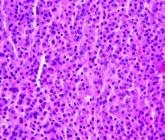News

CAC scoring pinpoints stenoses in asymptomatic diabetes patients
- Author:
- Andrew D. Bowser
Incorporating coronary calcium scoring into a silent myocardial ischemia screening algorithm “appears to be a...
News

High-frequency spinal cord stimulation eases painful diabetic neuropathy
- Author:
- Andrew D. Bowser
An implanted, high-frequency neuromodulation device relieved treatment-resistant diabetic neuropathy pain at 3...
News
Starting new diabetes drugs less likely for racial minorities, Medicare Advantage beneficiaries
- Author:
- Andrew D. Bowser
More work is needed to understand why DPP-4 inhibitors, GLP-1 receptor agonists, and SGLT2 inhibitors are not being used as often in patients that...
News
Pembrolizumab prolonged PFS vs. brentuximab vedotin in r/r Hodgkin lymphoma
- Author:
- Andrew D. Bowser
Pembrolizumab should be considered “the preferred treatment option and the standard of care” for patients with classic Hodgkin lymphoma not...
News
Pyrotinib bests lapatinib in HER2+ metastatic breast cancer
- Author:
- Andrew D. Bowser
Patients who received pyrotinib had longer progression-free survival but a higher rate of grade 3 diarrhea.
News
Trastuzumab deruxtecan proves active in HER2-mutated NSCLC
- Author:
- Andrew D. Bowser
The confirmed overall response rate was 61.9%, and the median duration of response has not been reached.
News
Short-course radiotherapy and chemo may reduce treatment failures in high-risk rectal cancer
- Author:
- Andrew D. Bowser
“Could it be we’re merely delaying distant metastases versus preventing them by more consistent use of systemic therapy sooner?”
News
TRAIN-2: Anthracyclines added toxicity, with no increased efficacy, in HER2+ breast cancer
- Author:
- Andrew D. Bowser
Long-term results of TRAIN-2 suggest clinicians should “think carefully” before using anthracyclines in patients...
News
First-line nivolumab plus platinum/etoposide effective in extensive-stage SCLC
- Author:
- Andrew D. Bowser
While the primary endpoint of progression-free survival was met, the role of first line nivolumab remains...
News

DOACs linked to lower fracture risk versus warfarin in AFib patients
- Author:
- Andrew D. Bowser
The results suggest women may particularly benefit from DOAC use.
News

Quitting smoking just 2 years before lung cancer diagnosis may improve survival
- Author:
- Andrew D. Bowser
Lung cancer screening may represent a key opportunity to reach patients with a “never too late to quit” message...
News

Video coaching may relieve anxiety and distress for long-distance cancer caregivers
- Author:
- Andrew D. Bowser
Long-distance caregivers of cancer patients had significant reductions in distress and anxiety after video...
News

Transplant beats bortezomib-based therapy for MM, but questions remain
- Author:
- Andrew D. Bowser
Issues with the EMN02/HO95 trial mean that the role of autologous stem-cell transplantation in the novel agent...
News

Suicide prevention one key focus of upcoming NIMH strategic plan
- Author:
- Andrew D. Bowser
The much broader strategic plan to guide research efforts and priorities is set to be released in the next few weeks, Dr. Joshua Gordon said.
News

NSDUH data might underestimate substance use by pregnant women
- Author:
- Andrew D. Bowser
Substance use disorders may be more prevalent than previously appreciated.
